Karabiner 98k
The Karabiner 98 kurz (German: [kaʁaˈbiːnɐ ˌʔaxtʔʊntˈnɔʏntsɪç ˈkʊɐ̯ts]; "carbine 98 short"), often abbreviated Kar98k or K98k and often referred to as a "K98" (which was also a type of Polish carbine), is a bolt-action rifle chambered for the 7.92×57mm Mauser cartridge that was adopted on 21 June 1935 as the standard service rifle by the German Wehrmacht.[1] It was one of the final developments in the long line of Mauser military rifles. Although supplemented by semi- and fully automatic rifles during World War II, it remained the primary German service rifle until the end of the war in 1945.[4] Millions were captured by the Soviets at the conclusion of World War II and were widely distributed as military aid. The Karabiner 98k therefore continues to appear in conflicts across the world as they are taken out of storage during times of strife.
| Karabiner 98 kurz | |
|---|---|
 Karabiner 98k in mint condition, made in 1940. From the collections of the Swedish Army Museum | |
| Type | Bolt-action rifle |
| Place of origin | |
| Service history | |
| In service | 1935–present |
| Used by | See Users |
| Wars | See List of conflicts and wars |
| Production history | |
| Designed | 1935 |
| Manufacturer | Mauser (augmented by several other makers) |
| Unit cost | 55 RM (1935) 230 EUR current equivalent |
| Produced | 1935–1945 |
| No. built | 14,600,000+[1][2] |
| Variants | Kriegsmodell, scoped |
| Specifications | |
| Mass | 3.7–4.1 kg (8.2–9.0 lb)[3] |
| Length | 1,110 mm (43.70 in) |
| Barrel length | 600 mm (23.62 in) |
| Cartridge | 7.92×57mm Mauser[3] |
| Action | Bolt-action[3] |
| Muzzle velocity | 760 m/s (2,493 ft/s) |
| Effective firing range | 500 m (550 yd) with iron sights ≥1,000 m (1,090 yd) with telescopic sight |
| Maximum firing range | 4,700 m (5,140 yd) with s.S. Patrone |
| Feed system | 5-round stripper clip, internal magazine |
| Sights | Iron sights or telescopic sight. |
History
In February 1934 the Heereswaffenamt (Army Weapons Agency) ordered the adoption of a new military rifle. The Karabiner 98k was derived from earlier rifles, namely the Mauser Standardmodell of 1924 and the Karabiner 98b, which in turn had both been developed from the Gewehr 98. Since the Karabiner 98k rifle was shorter than the earlier Karabiner 98b (the 98b was a carbine in name only, it was a version of the Gewehr 98 long rifle designated a carbine to adhere to the Treaty of Versailles. The 98b was additionally fitted with a tangent rear sight rather than the more claustrophobic "Lange" ramp sight). The new rifle was given the designation Karabiner 98 kurz, meaning "Carbine 98 Short". Just like its predecessor, the rifle was noted for its reliability, great accuracy and an effective range of up to 500 metres (550 yd) with iron sights and 1,000 metres (1,090 yd) with an 8× telescopic sight.[5]
The desire for adopting new shorter barreled rifles and the introduction of the Karabiner 98k, featuring a 600 mm (23.62 in) long barrel, were reasons for changing the standard German service ball rifle cartridge. The 1903 pattern 7.92×57mm Mauser S Patrone produced excessive muzzle flash when fired from arms that did not have a long barrel like the Gewehr 98. It was found that the s.S. Patrone, originally designed for long range machine gun use, produced less muzzle flash out of rifles that had a shorter barrel and also provided better accuracy. Because of this the S Patrone was phased out in 1933 and the s.S. Patrone became the standard German service ball cartridge in the 1930s.[6][7]
Design details
Features
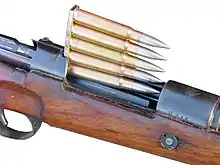

The Karabiner 98k is a controlled-feed bolt-action rifle based on the Mauser M98 system. Its internal magazine can be loaded with five 7.92×57mm Mauser cartridges from a stripper clip or one-by-one.[3] After loading, the empty clip is ejected when the bolt is closed. The straight bolt handle found on the Gewehr 98 bolt was replaced by a turned-down bolt handle on the Karabiner 98k. This change made it easier to rapidly operate the bolt, reduced the amount the handle projected beyond the receiver, and enabled mounting of aiming optics directly above the receiver. Each rifle was furnished with a short length of cleaning rod, fitted through the bayonet stud. The joined rods from 3 rifles provided one full-length cleaning rod.
The metal parts of the rifle were blued, a process in which steel is partially protected against rust by a layer of magnetite (Fe3O4). Such a thin black oxide layer provides only minimal protection against rust or corrosion, unless also treated with a water-displacing oil to reduce wetting and galvanic corrosion. From 1944 onwards phosphating/Parkerizing was introduced as a more effective metal surface treatment.[8]
Sights
The impractical Langevisier or "rollercoaster" rear sight of the Mauser Gewehr 1898 was replaced with a conventional tangent leaf sight. The Karabiner 98k rear tangent sight was flatter compared to and does not obstruct the view to the sides during aiming as the Langevisier. Originally, the Karabiner 98k iron sight line had an open-pointed-post-type (barlycorn) front sight, and a tangent-type rear sight with a V-shaped rear notch.[3] From 1939 onwards the post front sight was hooded to reduce glare under unfavourable light conditions and add protection for the post. These standard sight lines consisted of somewhat coarse aiming elements, making it suitable for rough field handling, aiming at distant area fire targets and low-light usage, but less suitable for precise aiming at distant or small point targets. It is graduated for 7.92×57mm Mauser s.S. Patrone cartridges loaded with 12.8 g (197 gr) s.S. (schweres Spitzgeschoß – "heavy pointed bullet") ball bullets from 100 to 2,000 m (109 to 2,187 yd) in 100 m (109 yd) increments. The sight line of early productions rifles have the ranging scale copied at the bottom of the tangent aiming element for setting the range whilst lying down. The Karabiner 98k has a 500 mm (19.7 in) sight radius.
Stock
Early Karabiner 98k rifles had solid one-piece stocks. From 1937 onwards the rifles had laminated stocks, the result of trials that had stretched through the 1930s.[8] Plywood laminates are stronger and resisted warping better than the conventional one-piece patterns, did not require lengthy maturing, and were cheaper. The laminated stocks were, due to their dense composite structure, somewhat heavier compared to one-piece stocks.[9] In addition to the use of walnut and beech laminate, elm was used in small quantities. The butts of the semi-pistol grip Karabiner 98k stocks were not uniform. Until early 1940 the stocks had a flat buttplate. After 1940 some stocks had a cupped buttplate to prevent the separation of the butt stock. All stocks had a steel buttplate.
Accessories

When issued the Karabiner 98k came accompanied with assorted accessory items including a sling, a protective muzzle cover, and for field maintenance a Reinigungsgerät 34 ("Cleaning Kit 34") or RG34 kit. Introduced in 1934, the Reinigungsgerät 34 consisted of a flat 85 mm (3.3 in) wide by 135 mm (5.3 in) long sheet metal container with two hinged lids carried on the person, which held an oiler, a take down tool for removing the floorplate and cleaning the receiver of the rifle, an aluminum barrel pull-through chain, a cleaning and an oiling brush, and short lengths of tow used as cleaning patches.[10] From 1905 until 1945 the German military used Ballistol intended for cleaning, lubricating, and protecting metallic, wooden and leather firearms parts.[11]
The Karabiner 98k rifle was designed to be used with an S84/98 III bayonet.[12] The S84/98 III had a blade length of 252 mm (9.9 in) and an overall length of 385 mm (15.2 in) and was accompanied by a bayonet frog.[13] The Seitengewehr 42 or SG 42 was a shorter multi tool combat knife that could also be mounted as a bayonet on the Karabiner 98k rifle. The SG 42 was issued in small numbers.
Rifle grenade launcher

In 1942, an attachable rifle grenade launcher called the Gewehrgranatengerät or Schiessbecher ("shooting cup") was introduced that was developed based on rifle grenade launcher models designed during World War I. The 30 mm Schiessbecher cup-type rifle grenade launcher could be mounted on any Karabiner 98k and was intended to replace all previous rifle grenade launcher models. The rifle grenade launcher could be used against infantry, fortifications and light armored vehicles up to a range of 280 m (306 yd). For these differing tasks, several specialized grenades with accompanying special propelling cartridges were developed for the 1,450,113 produced Schiessbecher rifle grenade launchers. The rifle grenade-propelling cartridges fired a wooden projectile through the barrel to the rifle grenade that, upon impact, automatically primed the rifle grenade. The Schiessbecher could be mounted on the Karabiner 98a, G98/40, StG 44 and FG 42.[14]
ZF41 long eye relief optical sight

Starting from 1941, the short 1.5× Zielfernrohr 41 (ZF41) long eye relief telescopic sight was fitted over the rear iron sight element to some Karabiner 98k rifles for designated marksman use. Adding the ZF411 to the rifle turned the Karabiner 98k essentially into an early somewhat big and heavy scout rifle, though that concept did not exist at that time. The ZF41 was in fact the first attempt to provide the ordinary infantryman with a rifle capable of being used for sharpshooting. Early production ZF41 were matched, zeroed and fitted on Karabiner 98k rifles selected for being exceptionally accurate at the factory before issue. After the devolpment of a field replaceble mount the ZF41 sights were issued to be mounted on random Karabiner 98 k rifles by field armorers. This led to an inevitable reduction in accuracy in lots of these field fitted rifles. By the end of the war in 1945, more than 100,000 Zf41 sights had been produced, the largest production of German optical sights during the war.
Suppressor
A removable, muzzle-mounted HUB-23 suppressor, visually resembling the Schießbecher, was manufactured for the Karabiner 98k. After several suppressor proposals from the firearms industry and the SS-Waffenakademie (SS Weapons Academy) the HUB-23 was produced based on a design proposal by Unteroffizier Schätzle. The HUB-23 weighs 0.5 kg (1.1 lb) and is 180 mm (7.1 in) long. The maximum effective range of a Karbiner 98k with a HUB-23 mounted and firing special subsonic Nahpatrone ("near cartridge") reduced load ammunition with a muzzle velocity of 220 m/s (722 ft/s) was 300 m (330 yd). The use of the HUB-23 suppressor and subsonic ammunition resulted in a sound signature reduction by 75%.[15] The HUB-23 suppressor and the special subsonic ammunition were mainly used by special forces units such as the Brandenburgers and snipers.
Variants

Kriegsmodell
Starting in late 1944, Karabiner 98k production began transition to the Kriegsmodell ("war model") variant. This version was simplified to increase the rate of production, removing the bayonet lug, cleaning rod, stock disc (which functions as a bolt disassembly tool), and other features deemed to be unnecessary.[16] Non-critical parts like the stock were finished to lower standards and metal parts like the nose cap, barrel band, floor plate and trigger guard (lacking the small locking screw provision) had become simplified stamped parts that were less elaborately mounted to the rifle. The M98 bolt was also simplified by stopping milling the two oval-shaped emergency gas relief holes in the bottom of the bolt. Instead two emergency gas relief holes were drilled and the bolt guide was omitted from the bolt body. It had less serial numbered parts, a phosphate metal surface finish, and a hole at the bottom end of the butt plate that replaced the stock disk. At least two transitional variants existed, which incorporated only some Kriegsmodell features, and some factories never switched to Kriegsmodell production at all.[17]
Sniper variant

For snipers, Karabiner 98k rifles selected for being exceptionally accurate during factory tests were fitted with a telescopic sight as sniper rifles. Karabiner 98k sniper rifles had an effective range of up to 1,000 m (1,094 yd) when used by a skilled sniper. The German Zeiss Zielvier 4× (ZF39) telescopic sight had bullet drop compensation in 50 m (55 yd) increments for ranges from 100 to 800 m (109 to 875 yd) or in some variations from 100 to 1,000 m (109 to 1,094 yd). There were ZF41 1.5×, Zeiss Zielsechs 6× and Zielacht 8× telescopic sights by various manufacturers like the Ajack 4× and 6×, Hensoldt Dialytan 4×, Kahles Heliavier 4× and Opticotechna Dialytan 4× with similar features employed on Karabiner 98k sniper rifles.[18] Several different mountings produced by various manufacturers were used.[19] The Karabiner 98k was not designed to accept telescopic sights.[20] Attaching such sights to a Karabiner 98k required machining by a skilled armourer. A telescopic sight mounted low above the center axis of the receiver will not leave enough space between the rifle and the telescopic sight body for unimpaired operation of the bolt handle or the three-position safety catch lever. This ergonomic problem was solved by mounting the telescopic sight relatively high above the receiver and sometimes modifying or replacing the safety operating lever or using an offset mounting to position the telescopic sight axis to the left side in relation to the receiver center axis. A common minor modification was replacing the stock buttplate with a waffled anti-slip "sniper" buttplate. Approximately 132,000 of these sniper rifles were produced by Germany.[21]
Paratrooper variants
Experimental versions of the Karabiner 98k intended for the German paratroopers that could be transported in shortened modes were produced. The standard Karabiner 98k was too long to be carried in a parachute drop. However, the German paratroopers made only limited combat drops after the 1941 Battle of Crete; there was therefore little need for these rifles. Specimens with folding stocks (Klappschaft) and with detachable barrels (Abnehmbarer Lauf) are known to have been produced at Mauser Oberndorf.[8]
G40k
The G40k with a total length of 1,000 mm (39.37 in) and a barrel length of 490 mm (19.29 in) and 3.2 kg (7.1 lb) weight was a shortened experimental version of the Karabiner 98k.[8][21] The rear tangent sight of the G40k was graduated for s.S. Patrone cartridges from 100 m to 1000 m in 100 m increments. A batch of 82 G40k rifles was produced in 1941 at Mauser Oberndorf.[22]
Mauser KKW cadet rifle
The Mauser KKW cadet rifle is a single shot, .22 caliber rifle that was introduced in 1938. It is virtually identical to the Karabiner 98k. These cadet rifles were used by all German military, paramilitary and police organizations, especially the Hitler Youth.
Receiver codes

Karabiner 98k receivers were stamped with a factory code indicating date and location of manufacture. These codes were originally prefixed with "S/" and suffixed with "K" for 1934 or "G" for 1935. The intervening numeric code indicated location. The two- or four-digit year of manufacture was stamped on the receiver ring instead of a letter suffix after 1935. The numeric codes were:
- 27 for Erfurter Maschinen- und Werkzeugfabrik (ERMA) in Erfurt
- 42 for Mauser in Oberndorf am Neckar
- 147 for Sauer & Sohn in Suhl
- 237 for Berlin-Lübecker Maschinenfabrik in Lübeck
- 243 for Mauser in Borsigwalde
- 337 for Gustloff Werke in Weimar
- 660 for Steyr-Daimler-Puch in Steyr
- 945 for Waffenwerke Brünn in Brno
The "S/" prefix was dropped and letters were used for location codes beginning in 1937, although some manufacturers retained the numeric codes past that date. The letter codes were:
- ar for Mauser in Borsigwalde
- ax for Erma Werke
- bcd for Gustloff Werke
- bnz for Steyr-Daimler-Puch
- BSW for Berlin-Suhler Waffen und Fahrzeugwerke
- byf for Mauser in Oberndorf am Neckar
- ce for Sauer & Sohn
- dot for Waffenwerke Brünn in Brno
- dou for Waffenwerke Brünn in Bystrica
- duv for Berlin-Lübecker Maschinenfabrik
- svw45 for Mauser 1945 production in Oberndorf am Neckar
- swp45 for Waffenwerke Brünn 1945 production in Brno
Combined production by multiple manufacturers are indicated by two codes separated by a slash.[23]
German small arms doctrine
The Karabiner 98k had the same disadvantages as all other military rifles designed around the year 1900 in that it was comparatively bulky and heavy, having been created during a time when military doctrine centered around highly trained marksmen engaging at relatively long range. The rate of fire was limited by how quickly the bolt could be operated. Its magazine had only half the capacity of Great Britain's Lee–Enfield series rifles, but being internal, it made the weapon more comfortable to carry at its point of balance. An experimental trench magazine was produced during World War I (originally intended only for the original Gewehr 98 but it could be made to work with all Model 98 variants) that could be attached to the bottom of the internal magazine by removing the floor plate, increasing capacity to 20 rounds, though it still required loading with 5-round stripper clips.
While the Americans had standardized a semi-automatic rifle in 1936 (the M1 Garand), the Germans maintained these bolt-action rifles due to their tactical doctrine of basing a squad's firepower on the general-purpose machine gun in the light machine gun role so that the role of the rifleman was largely to carry ammunition and provide covering fire for the machine gunners. The advantage of the general purpose machine gun concept was that it added greatly to the overall volume of fire that could be put out by a squad-sized unit.[24][25] They did experiments with semi-automatic rifles throughout the war and fielded the Gewehr 43/Karabiner 43 series of which 402,713 were built, and introduced the first assault rifle in 1943 – the MP43 / MP44 / StG 44 series, of which 425,977 were built. Due to the relatively limited production of semi-automatic and assault rifles, the Karabiner 98k remained the primary service weapon until the last days of the war, and was manufactured until the surrender in May 1945.
In close combat, however, submachine guns were often preferred, especially for urban combat, where the rifle's range and low rate of fire were not very useful, although the rifle's powerful ammunition was better able to penetrate walls and other cover found in urban areas. Towards the end of the war, it was intended to phase out the Karabiner 98k in favour of the StG 44, which fired the 7.92×33mm Kurz intermediate rifle round that was more powerful than the pistol cartridges of submachine guns, but that could be used like a submachine gun in close-quarters and urban fighting. Production of the StG 44, being a late-war weapon, was never sufficient to meet demand and did not come near to the 1,500,000 ordered nor the 4,000,000 planned.[26]
Usage history
Pre–World War II export

Though most Karabiner 98k rifles went to the German armed forces, the weapon was sold abroad in the years prior to World War II. In Portugal, a large quantity of Karabiner 98k rifles made by Mauser Werke were adopted as the Espingarda 7,92 mm m/937 Mauser infantry rifle.[27] They were later used during the Portuguese Colonial War.[28] Other pre-war exports of Karabiner 98ks were to China (an unknown number of rifles 1935 - 38),[29] and 20,000 in 1937 to (China's then-enemy) Japan.[30] Exports of Karabiner 98ks decreased as war drew closer, as all available production capacity was needed to equip the German Armed Forces.
World War II use
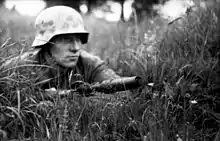
The Mauser Karabiner 98k rifle was widely used by all branches of the armed forces of Germany during World War II. It saw action in every theatre of war involving German forces, including occupied Europe, North Africa, the Soviet Union, Finland, and Norway. Although comparable to the weapons fielded by Germany's enemies at the beginning of the War, its disadvantages in rate of fire became more apparent as American and Soviet armies began to field more semi-automatic weapons among their troops. Still, it continued to be the main infantry rifle of the Wehrmacht until the end of the War. Resistance forces in German-occupied Europe made frequent use of captured German Karabiner 98k rifles. The Soviet Union also made extensive use of captured Karabiner 98k rifles and other German infantry weapons due to the Red Army experiencing a critical shortage of small arms during the early years of World War II. Many German soldiers used the verbal expression "Kars" as the slang name for the rifle.
Sweden ordered 5,000 Karabiner 98ks that were provided from the regular production run in 1939[31] for use as light anti-tank rifles under the designation gevär m/39 (rifle m/39) but it was soon evident that the penetration offered by the 7.92×57mm Mauser was inadequate and thus the gevär m/39 were rechambered to the 8×63mm patron m/32, which was a more powerful 8 mm cartridge specifically designed for long-range machinegun fire.[32] Accordingly, the Karabiner 98ks were rechambered in Sweden for the 8×63mm patron m/32 and the internal box magazine of the M 98 system was adapted to match the dimensionally larger 8×63mm patron m/32 cartridge, reducing the capacity to 4 rounds and accepted into service as pansarvärnsgevär m/40.[33] A muzzle brake was installed to reduce the excessive free recoil, and the resulting weapon was designated gevär m/40 in Swedish service. They were however also found to be unsatisfactory and were soon withdrawn from service, and sold off after WW II.[34]
Soviet capture

During World War II, the Soviet Union captured millions of Mauser Karabiner 98k rifles and re-furbished them in various arms factories in the late 1940s and early 1950s. These rifles, referred to by collectors as RC ("Russian Capture") Mausers, can be identified by an "X" stamp on the left side of the receiver. The Soviet arsenals made no effort to match the rifle's original parts by serial number when reassembling them, and some metal parts (the cleaning rod, sight hood, and locking screws) were omitted after rebuilding, and instead were melted down and recycled, presumably with the other parts that weren't suitable for re-use.
Many of these rifles (along with the Mosin–Nagant rifle) served in conflicts after World War II. One example of Soviet-captured Mauser Kar98k rifles being used in post-WWII conflicts is the Korean War, where a number of these rifles were provided by the Soviet Union (along with Soviet-made small arms) to Chinese Communist forces to supplement their supply of Type Zhongzheng rifles. Both the Soviet-capture Kar98k rifle and the Chinese Type Zhongzheng rifle were used extensively by the People's Volunteer Army throughout the course of the Korean War.
The Korean War would not be the only conflict where Soviet-capture Kar98k rifles and WWII German small arms were provided to the allies of the Soviet Union. The Vietnam War would become another example with Soviet-capture Mauser Karabiner 98k rifles being provided to North Vietnam by the USSR as military aid. Many Soviet-capture Karabiner 98k rifles (as well as some Karabiner 98k rifles that were left behind by the French after the First Indochina War and Type Zhongzheng rifles provided by the People's Republic of China) were found in the hands of Viet Cong guerrillas and People's Army of Vietnam (NVA) soldiers by US, South Vietnamese, South Korean, Australian and New Zealand forces alongside Soviet-bloc rifles like the Mosin–Nagant, the SKS, and the AK-47.[35]
Post-occupation service
In the years after World War II, several European nations on both sides of the Iron Curtain that were invaded and occupied by Nazi Germany used the Mauser Karabiner 98k rifle as their standard-issue infantry rifle, due to the large number of German weapons that were left behind by the Germans at the end of World War II.
Nations like France and Norway used the Mauser Karabiner 98k rifle and other German weapons in the years after World War II. France produced a slightly modified version of the Kar 98k in the French occupation zone of Germany in the immediate post-war period. The new manufacture Kar 98ks equipped some French units that used them in Indochina for a limited time.[36] Some of these rifles were also used by pro-French second-line units and Algerian independentists during Algerian War.[37] French Police forces, the Paris Police Prefecture and the Compagnies Républicaines de Sécurité, used 98ks from 1945 to 1992, to fire lachrymator and smoke grenades.[38] These rifles were also used by West German border guards.[39]
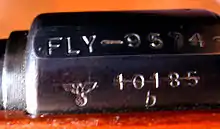
Norway's captured Karabiner 98k rifles were soon superseded as a standard issue weapon by the US M1 Garand, but remained in service as Norwegian Home Guard weapons until at least the 1970s, in which role they were rebarreled for the .30-06 Springfield round used by the M1, with a small cutout in the receiver so that the slightly longer US round could still be loaded with stripper clips. These Norwegian conversions had a section of the receiver flattened on the upper left side, where a new serial number (with a prefix denoting the branch of service) was stamped. Some of these rifles conversions were rechambered again to 7.62×51mm NATO,[36] but this program was canceled with only a few thousand converted when Norway adopted the AG-3 (H&K G3) as a replacement for both the M1 and the K98k. Some actions from Mauser Karabiner 98k left by German armed forces in 1945 were used by Kongsberg Våpenfabrikk (currently Kongsberg Small Arms) for building both military and civilian sniper/target rifles under the Kongsberg Våpenfabrikk Skarpskyttergevær M59 - Mauser M59 and Kongsberg Våpenfabrikk Skarpskyttergevær M67 - Mauser M67 designations. These rifles were used by the Norwegian armed forces up to the 2000s.
In West Germany, the Karabiner 98k were issued to the Bundesgrenzschutz (BGS; English: Federal Border Guard), which was originally organized along paramilitary lines and armed as light infantry; in the 1950s.[40]
Former German Karabiner 98k rifles were widely distributed throughout the Eastern Bloc, some being refurbished two or three times by different factories. They were used by military and para-military forces (such as the East German Combat Groups of the Working Class), and were replaced by Soviet weapons in the 1960s.
During the Greek Civil War, the Greek pro-communist factions were equipped with large numbers of Kar 98k rifles, captured from the Germans or supplied by Yugoslavia.[41] Later, during the Cyprus Emergency, the Cypriot EOKA smuggled several dozens of these rifles from Greece.[42]

East German refurbished Karabiner 98ks featured Russian-style thicker blue finish, a 'sunburst' proof mark and sometimes had the factory designation '1001' applied, which was the factory where the refurbishment was carried out. Numbers were re-stamped to match the receiver and old numbers barred out. Numbers of East German and Czech refurbished Karabiner 98ks were exported to the West in the late 1980s and early 1990s and are now in the hands of collectors. Russian Capture Karabiner 98ks were exported to the West in large numbers in the early and mid-2000s.
Yugoslavian postwar refurbishment
Because of the lack of weapons after World War II, the Yugoslavian arms producer Crvena Zastava (Nowadays Zastava Arms) refurbished German Karabiner 98k rifles that were left over or captured during the war. These rifles are readily identifiable as the German factory code markings have been scrubbed from the receiver and replaced with the Yugoslavian communist crest and the marking "Preduzeće 44" on the receiver's ring. In addition to this, if the refurbishment took place after 1950, the marking "/48" was added to the "Mod. 98" originally present on the left side of the receiver, becoming "Mod. 98/48". The refurbished rifles were known also as Zastava M 98/48. The refurbished Prеduzeće 44 Karabiner 98k rifles were still being used in the Yugoslav Wars of the 1990s.
Post–World War II derivatives
Many of the liberated European countries continued production of rifles similar to the Karabiner 98k, for example Fabrique Nationale (FN) in Belgium[43] and Česká Zbrojovka (CZ) in Czechoslovakia produced both their proprietary older models and brand new Karabiner 98k rifles, many of which were assembled from leftover German parts or using captured machinery.
As with post-Nazi occupation service post-war production of derivatives was a stop-gap solution until enough numbers of more modern automatic rifles could be developed and produced. The vast majority of the 98k pattern rifles were soon stored as reserve weapons or given for very low prices to various fledgling states or rebel movements throughout the developing world. For instance, between 1950 and 1952, an hybrid of Kar 98k and Vz 24 was produced by Zbrojovka Brno for Bolivia, as Fusil Modelo Boliviano Serie B-50.[44]
Both FN and CZ utilized a modified Kriegsmodell design, with the cleaning rod and stock disk omitted, but the bayonet lug restored. In Czechoslovakia it was known as P-18 or puška vz.98N, the first being the manufacturer's cover designation of the type, the second official army designation - rifle model 98, N for německá - German.
Yugoslavian M48
From 1948 to 1965, Yugoslavian Zastava Arms produced a close copy of the Karabiner 98k imported between the wars from Fabrique Nationale called the Model 1948, which differed from the German rifle in that it had the shorter bolt-action of the Yugoslav M1924 series of rifles (not to be confused with the widely distributed Czech Vz 24, which had a standard length action), a thicker barrel profile (Yugoslavia had low chromium iron ore deposits, so they could not produce steel as hardened as the Krupp or Swedish steel used in other variants, and made up for it in adding extra material), and a rear sight enclosed in the wooden hand guard (the German-style hand guard began in front of the rear sight, unlike e.g. exports to South America that had a handguard and rear sight like the M48).
A hunting variant of the Yugoslavian M48 is still produced by Zastava Arms, it is designated as the Zastava Arms M70 Bolt Action Rifle now.
Spanish M43
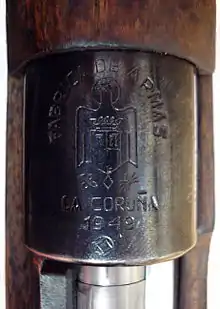
The Spanish M43, produced in A Coruña from 1944 to 1958,[45] was a variant of the Karabiner 98k with a straight bolt handle, a front sight guard and a handle groove in the front stock much like the earlier Reichspostgewehr.[46] It was chambered in 7.92×57mm Mauser calibre. It was the standard rifle of the Spanish units during the Ifni War.[47] Some were rebuilt from Gewehr 98 or Republican wz. 29 rifles.[45][48] The Spanish Air Force had a slightly modified version, the M44.[48] When Spain began switching to the CETME automatic rifle, many M43 were converted to FR8 rifles for military training purposes and Guardia Civil service.[49]
Israeli Mauser
.jpg.webp)
A number of non-European nations used the Mauser Karabiner 98k rifle as well as a few guerrilla organizations in conflicts to establish new nation-states. Israel issued Mauser Karabiner 98k rifles from the late 1940s until the 1970s, which are today sought after by collectors. Many were acquired under Operation Balak.[50]
Many Jewish organizations in Palestine acquired them from post–World War II Europe to protect various Jewish settlements from Arab attack as well as to carry out guerrilla operations against British Army forces in Palestine.
The Haganah, which later evolved into the modern-day Israel Defense Forces, was one of the Jewish armed groups in Palestine that brought large numbers of Mauser Karabiner 98k rifles and other surplus arms (namely the British Lee–Enfield bolt-action rifle, which was used on a large scale by these groups) and the Mosin–Nagant from Europe after World War II. Many, though not all, Israeli-used German surplus Mauser Karabiner 98k rifles have had their Nazi Waffenamt markings and emblems stamped over with Israel Defense Forces (IDF) and Hebrew arsenal markings.
As the Arab-Israeli conflict approached, the Haganah and other Jewish forces in Palestine tried to get hold of as many weapons as they could in the face of an arms embargo by British colonial authorities. One of the most important purchases was a secret January 14, 1948, $12,280,000 worth contract with Czechoslovak Government including 4,500 P-18 rifles, as well as 50,400,000 rounds of ammunition. Later, the newly established Israel Defense Forces ordered more Mauser Karabiner 98k rifles, produced this time by Fabrique Nationale.[43] These have Israeli and Belgian markings on the rifle as well as the emblem of the IDF on the top of the rifle's receiver. The FN-made Karabiner 98k rifles with the IDF markings and emblem on the rifle were produced and sold to Israel after it established itself as an independent nation in 1948. At some point, Israel converted all other Mauser 98-pattern rifles in their inventory (most commonly Czechoslovak vz. 24 rifles, but small numbers of contract Mausers from sources ranging from Ethiopia to Mexico were also known to have come into Israeli hands) to the now standardized Karabiner 98k configuration. The original receiver markings of these conversions were not altered, making it easy for collectors to identify their origin. The Israeli Karabiner 98k utilized the same bayonet design as in German service, with a barrel ring added. Swedish Gevär m/40 rifles were converted to the 7.92 Mauser round.[51] The Israeli bayonets were a mix of converted German production and domestically produced examples.
During the late 1950s, the IDF converted the calibre of their Mauser Karabiner 98k rifles from the original German 7.92×57mm Mauser round to 7.62×51mm NATO following the adoption of the FN FAL rifle as their primary rifle in 1958.[52] The Israeli Mauser Karabiner 98k rifles that were converted have "7.62" engraved on the rifle receiver. Rifles with original German stocks have "7.62" burned into the heel of the rifle stock for identification and to separate the 7.62 NATO rifles from the original 7.92 mm versions of the weapon still in service or held in reserve. Some Karabiner 98k rifles were fitted with new, unnumbered beech stocks of recent manufacture, while others retained their original furniture. All of these converted rifles were proof-fired for service. The IDF employed a 22 mm rifle grenade adapter for the Mauser K98k rifle.[53]
The Karabiner 98k rifle was used by the reserve branches of the IDF well into the 1960s and 1970s and saw action in the hands of various support and line-of-communications troops during the 1967 Six-Day War and the 1973 Arab-Israeli War.[52] After the rifle was retired from reserve military service, the Israeli Mauser Karabiner 98k was given to a number of third-world nations as military aid by Israel during the 1970s and 1980s, and sold as ex-military surplus on the open market, with many Israeli Mausers being exported to Australia (the Israeli Mauser is the most predominant variant of the Mauser Kar98k rifle on the Australian surplus firearms market today) and North America during the 1970s and 1980s. The Israeli Mausers provided to third world armies began to be exported for civilian sale, and tend to be in significantly worse condition than those sold directly out of Israeli storage.
Contemporary use

The Bundeswehr still uses the Karabiner 98k in the Wachbataillon for military parades and show acts. In 1995, remaining swastikas and other Nazi-era markings were removed from these rifles, after criticism regarding the presence of such symbols on Wachbataillon kit by the Social Democratic Party.[54]
During the 1990s, the Yugoslavian Karabiner 98k rifles and the Yugoslavian M48 Mauser and M48A rifles were used alongside modern automatic and semi-automatic rifles by all the warring factions of the Yugoslav Wars. There are a number of photographs taken during the war in Bosnia, showing combatants and snipers using Yugoslavian-made Mauser rifles from high-rise buildings in the Bosnian city of Sarajevo.[55]
After 2003, the Mauser Karabiner 98k rifle (along with the Mosin–Nagant, the Lee–Enfield and the Yugoslavian M48) was encountered in Iraq by US and Allied forces with Iraqi insurgents making use of the Karabiner 98k and other bolt-action rifles alongside more modern infantry weapons like the AK-47 series rifles and the SKS carbine.[56]
Many Third World nations still have Karabiner 98k rifles in their arsenals and it will most likely be encountered in regional conflicts for many years to come. For instance, Tuaregs of the People's Movement for the Liberation of Azawad used during Tuareg rebellion (1990–1995).[57]
Civil use



The Karabiner 98k rifles that were used by Germany during World War II are highly sought after collector's items in many circles. The Mauser Karabiner 98k rifle remains popular among many rifle shooters and military rifle collectors due to the rifle's historical background, as well as the availability of both new and surplus 7.92×57mm IS ammunition. As of 2010, the Mauser Karabiner 98k rifles that were captured by the Soviets during World War II and refurbished during the late 1940s and early 1950s have appeared in large numbers on the military surplus rifle market. These have proven popular with buyers in the United States and Canada, ranging from ex-military rifle collectors to target shooters and survivalists, due to the unique history behind the Soviet capture of Mauser Karabiner 98k rifles.
The widespread availability of surplus Mauser 98k rifles and the fact that these rifles could, with relative ease, be adapted for hunting and other sport purposes made the Mauser 98k popular amongst civilian riflemen. When German hunters after World War II were allowed again to own and hunt with full bore rifles they generally started to "rearm" themselves with the then abundant and cheap former Wehrmacht service rifles. Civilian users changed these service rifles often quite extensively by mounting telescopic sights, aftermarket hunting stocks, aftermarket triggers and other accessories and changing the original military chambering. Gunsmiths rebarreled or rechambered Mauser 98K rifles for European and American sporting chamberings such as the 6.5×55mm Swedish Mauser, 7×57mm Mauser, 7×64mm, .270 Winchester, .308 Winchester, .30-06 Springfield, 8×60mm S, 8×64mm S, etc. The magnum hunting cartridges 6.5×68mm, 8×68mm S and 9.3×64mm Brenneke were even specially developed by German gunsmiths for the standard military Mauser 98 action.
Surplus Mauser 98K actions were used by Schultz & Larsen in Denmark as the basis for target rifles. The actions had the German markings removed, were refinished in gray phosphate, and new serial numbers and proof marks applied. The Schultz & Larsen M52 and M58 Target Rifles used shortened and refurbished Karabiner 98k stocks. Later versions had new target stocks fitted and were available in .30-06, 6.5×55mm and 7.62mm NATO. Some of these rifles are still in competitive use today although with the benefit of new barrels. Besides conversions of original Karabiner 98k rifles other sporter variants made by a number of manufacturers such as FN Herstal, Zastava, Santa Barbara (Spain) and many others have been available at various times in a wide variety of chamberings, but most are large-bore hunting calibres.
Modern civilian offspring
The Mauser-type action is widely held to be the pinnacle of bolt-action rifle design, and the vast majority of modern weapons of this type, both military and civilian, are still based on it to this day. The safety offered by its three-lug bolt and the added reliability of controlled feed (especially favored by dangerous game hunters) are considerable refinements not found in other designs.
Throughout the design's history, standard sized and enlarged versions of the Mauser M 98 system have been produced for the civil market.
John Rigby & Co. commissioned Mauser to develop the M 98 magnum action in the early 1900s. It was designed to function with the large sized cartridges normally used to hunt Big Five game and other species. For this specialized type of hunting, where absolute reliability of the rifle under adverse conditions is very important, the controlled-feed M 98 system remains the standard by which other action designs are judged.[58] In 1911 John Rigby & Co. introduced the .416 Rigby cartridge that due to its dimensions could only be used in the M 98 magnum action.[59]
Zastava Arms currently (2010) manufactures the M48/63 sporting rifle, which is a short-barreled variant of the Model 1948 military rifle and the Zastava M07 sniper rifle.[60][61]
Since 1999 the production of Mauser M 98 and M 98 Magnum rifles has been resumed in Germany by Mauser Jagdwaffen GmbH[62] (Mauser Huntingweapons Ltd.) according to original drawings of 1936 and the respective Mauser patents.[63]
Users

 Algeria: Used by Armée de Libération Nationale guerrillas[64]
Algeria: Used by Armée de Libération Nationale guerrillas[64] Austria[65]
Austria[65] Bolivia: Czech-made Modelo B-50[44]
Bolivia: Czech-made Modelo B-50[44] Republic of China: The Chinese Nationalist Government imported Karabiner 98k rifle, as they had with the Mauser Standardmodell before it, also producing a licensed copy of it domestically.[66]
Republic of China: The Chinese Nationalist Government imported Karabiner 98k rifle, as they had with the Mauser Standardmodell before it, also producing a licensed copy of it domestically.[66] People's Republic of China: Used by the People's Volunteer Army in the Korean War. Some of the Kar98k rifles the PVA used in Korea were provided as military aid by the USSR.[67]
People's Republic of China: Used by the People's Volunteer Army in the Korean War. Some of the Kar98k rifles the PVA used in Korea were provided as military aid by the USSR.[67].svg.png.webp) Independent State of Croatia: Used in large numbers by both Ustaše Militia and Croatian Home Guard[5]
Independent State of Croatia: Used in large numbers by both Ustaše Militia and Croatian Home Guard[5] Czechoslovakia: Used post-1945[68]
Czechoslovakia: Used post-1945[68] Denmark[68]
Denmark[68].svg.png.webp) Egypt: obtained from Czechoslovakia[69]
Egypt: obtained from Czechoslovakia[69] Finland: ordered 600 rifles with rifle grenade launchers during World War II as the Finns lacked a domestic rifle grenade launcher for their Mosin–Nagants. Only 100 were used in combat.[70]
Finland: ordered 600 rifles with rifle grenade launchers during World War II as the Finns lacked a domestic rifle grenade launcher for their Mosin–Nagants. Only 100 were used in combat.[70] France
France
 Germany: Used by the Bundeswehr's Wachbataillon [68]
Germany: Used by the Bundeswehr's Wachbataillon [68]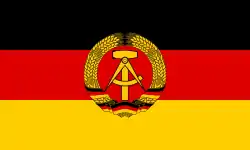 German Democratic Republic:[68] In standard use by the Landstreitkräfte until the 1960s, in occasional use after this. Some also used by the Kampfgruppen der Arbeiterklasse, in addition to some being sent as aid to the Ethiopian Derg Government.
German Democratic Republic:[68] In standard use by the Landstreitkräfte until the 1960s, in occasional use after this. Some also used by the Kampfgruppen der Arbeiterklasse, in addition to some being sent as aid to the Ethiopian Derg Government..svg.png.webp) Nazi Germany[5]
Nazi Germany[5] Israel[68]
Israel[68] Iraq[71]
Iraq[71]_crowned.svg.png.webp) Italy: some captured by Italian partisans[72]
Italy: some captured by Italian partisans[72] Japan: Used by the Imperial Japanese Navy[73]
Japan: Used by the Imperial Japanese Navy[73]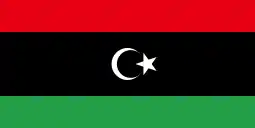 Libya: Used after World War II.[74] Fielded by Libyan Rebels during Libyan Civil War[75]
Libya: Used after World War II.[74] Fielded by Libyan Rebels during Libyan Civil War[75] Luxembourg: The Grand Ducal Guard used captured German K98ks in 1945, later replaced by Ross rifles in the same year.[76]
Luxembourg: The Grand Ducal Guard used captured German K98ks in 1945, later replaced by Ross rifles in the same year.[76].svg.png.webp) Mauritania[77]
Mauritania[77]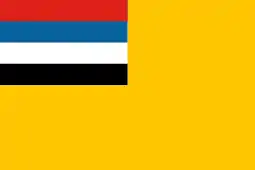 Manchukuo: used rifles captured from the Chinese forces[78]
Manchukuo: used rifles captured from the Chinese forces[78] Netherlands: Post-World War II use.[79]
Netherlands: Post-World War II use.[79] Norway[80] Some later converted to K98kF1[81]
Norway[80] Some later converted to K98kF1[81] Poland: (captured use)[82]
Poland: (captured use)[82] Portugal designated m/937[80]
Portugal designated m/937[80] Kingdom of Romania: 27,000 received from Germany in 1943[83]
Kingdom of Romania: 27,000 received from Germany in 1943[83] El Salvador: Kar 98k converted to 7.62 NATO bought before receiving surplus US weapons.[84]
El Salvador: Kar 98k converted to 7.62 NATO bought before receiving surplus US weapons.[84] Saudi Arabia: bought 1,000 Kar 98ks in the 1960s, probably to supply proxy forces.
Saudi Arabia: bought 1,000 Kar 98ks in the 1960s, probably to supply proxy forces. Serbia[5]
Serbia[5]
.svg.png.webp) First Slovak Republic[85]
First Slovak Republic[85] Soviet Union: (captured use)[86]
Soviet Union: (captured use)[86].svg.png.webp) Syrian Republic[87][88]
Syrian Republic[87][88] Sweden: Imported 5,000 Kar 98k rifles in 1939.[89]
Sweden: Imported 5,000 Kar 98k rifles in 1939.[89].svg.png.webp) Tunisia[90]
Tunisia[90] Turkey[79]
Turkey[79].svg.png.webp) North Vietnam[91]
North Vietnam[91] Yemen[92]
Yemen[92].svg.png.webp) Socialist Federal Republic of Yugoslavia[68]
Socialist Federal Republic of Yugoslavia[68]
Non-state users
.svg.png.webp) Albanian Partisans
Albanian Partisans East Timor: Some Ex-Portuguese m/937s used by FALINTIL during the early stages of Indonesian Invasion of East Timor.
East Timor: Some Ex-Portuguese m/937s used by FALINTIL during the early stages of Indonesian Invasion of East Timor..svg.png.webp) Ethiopian insurgents used captured K 98ks against the Italians from 1941 onwards.[93]
Ethiopian insurgents used captured K 98ks against the Italians from 1941 onwards.[93] Haganah (in Mandate Palestine)
Haganah (in Mandate Palestine) Indonesian insurgents used Kar 98ks captured from the Dutch during the Indonesian National Revolution[79]
Indonesian insurgents used Kar 98ks captured from the Dutch during the Indonesian National Revolution[79]%253B_Flag_of_Syria_(1963%E2%80%931972).svg.png.webp) Iraqi insurgents[56]
Iraqi insurgents[56] Korean Liberation Army[68]
Korean Liberation Army[68]- People's Movement for the Liberation of Azawad[57]
 Viet Cong[94] Some were ex-French leftovers from the Indochina War, others were Soviet aid provided during the Vietnam War.
Viet Cong[94] Some were ex-French leftovers from the Indochina War, others were Soviet aid provided during the Vietnam War..svg.png.webp) Viet Minh[36]
Viet Minh[36].svg.png.webp) Yugoslav Partisans[95][96] Some later had the receiver markings removed, and the SFRY crest applied postwar.
Yugoslav Partisans[95][96] Some later had the receiver markings removed, and the SFRY crest applied postwar.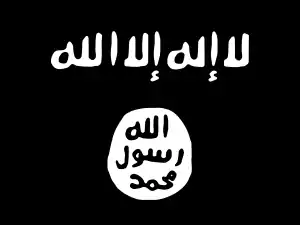 ISIL: Used by ISIL insurgents in 2019[97]
ISIL: Used by ISIL insurgents in 2019[97]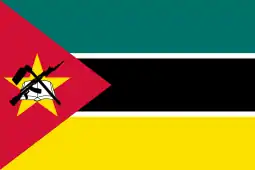 FRELIMO delivery of 4,800 Karabiner 98k from the German Democratic Republic in 1967[98]
FRELIMO delivery of 4,800 Karabiner 98k from the German Democratic Republic in 1967[98].svg.png.webp) Zimbabwe African People's Union delivery of 3,200 Karabiner 98k from the German Democratic Republic in 1967[98]
Zimbabwe African People's Union delivery of 3,200 Karabiner 98k from the German Democratic Republic in 1967[98] MPLA delivery of 1,600 Karabiner 98k from the German Democratic Republic in 1967[98]
MPLA delivery of 1,600 Karabiner 98k from the German Democratic Republic in 1967[98]
See also
| Wikimedia Commons has media related to Karabiner 98k. |
References
- K98k Mauser Page Archived 2007-03-29 at the Wayback Machine Retrieved 28 March 2007.
- French K98k and G40k Page—go to "sommaire" at the bottom of the page to use the index (in French) Archived 2008-02-02 at the Wayback Machine
- German Infantry Weapons. United States War Department. May 25, 1943. p. 23.
- Klein, Christopher. "What and when did WWII end". History.Com.
- Bishop, Chris (1998). The Encyclopedia of Weapons of World War II. New York: MetroBooks. p. 216. ISBN 1-58663-762-2. Retrieved 28 April 2018 – via Google Books.
- "Die Patrone 7.92mm (8x57)" (PDF). waffen-welt.de. Archived (PDF) from the original on 22 August 2016. Retrieved 28 April 2018.
- "20th Century German Military Arms and Ammo - RifleShooter". rifleshootermag.com. 18 February 2016. Archived from the original on 11 June 2017. Retrieved 28 April 2018.
- "waffenHQ.de ........ die Welt der Waffen". www.waffenhq.de. Archived from the original on 20 October 2017. Retrieved 28 April 2018.
- Ball, Robert W.D. (2011). Mauser Military Rifles of the World (5 ed.). Gun Digest Books. pp. 222, 227. ISBN 978-1-4402-1544-5.
- "Rifle Cleaning Kit 34 (Reinigungsgerät 34)". Archived from the original on 2012-01-13.
- "About Us - Ballistol". ballistol.com. Archived from the original on 9 September 2017. Retrieved 28 April 2018.
- REME Museum Page S84/98 III bayonet Archived April 3, 2007, at the Wayback Machine
- "German Bayonets for the Mauser 98-system used 1914-1945". Archived from the original on 2011-06-11.
- "Der Schießbecher (Gewehrgranatengerät)" (in German). Archived from the original on 2010-08-22.
- "Lexicon der Wehrmacht Gewehre" (in German). Archived from the original on 2011-07-17.
- "Firearms and Uniforms of the Wehrmacht". www.wehrmacht-awards.com. Archived from the original on 5 October 2017. Retrieved 28 April 2018.
- Kriegsmodell
- Military and commercial telescopic sights and mountings used on Karabiner 98k rifles
- "Übe Auge und Hand fürs Vaterland, Die Waffen der Deutsche Jäger und Scharfschützen, Teil 3" (PDF). frankonia.de (in German). Archived (PDF) from the original on 21 October 2016. Retrieved 28 April 2018.
- Senich, Peter R. (1982). The German sniper, 1914–1945 (1982 ed.). Paladin Press. ISBN 978-0-87364-223-1.
- French K98k and G40k Page Archived 2008-02-02 at the Wayback Machine
- Ball 2011, p. 222
- Gilbert, Glenn M. (2006). "Mauser Kar. 98k Receiver Codes". American Rifleman. National Rifle Association. 154 (September): 22&24.
- Hogg, Ian V., & Weeks, John. Military Small-Arms of the 20th century (London: Arms & Armour Press, 1977), p.183, "US Rifle, Caliber .30in ('Garand'), M1-M1E9, MiC, M1D, T26".
- Bull, Stephen (25 May 2004). World War II Infantry Tactics: Squad and Platoon. Elite 105. Osprey Publishing. pp. 22–23. ISBN 9781841766621.
- Erenfeicht, Leszek (30 September 2013), "Sturmgewehr: Hitler's Only True Wunderwaffe", SAdefensejournal.com, archived from the original on 19 October 2013
- Reynolds, Dan, The Rifles of Portugal 1880–1980, "Archived copy". Archived from the original on 2008-10-05. Retrieved 2008-09-09.CS1 maint: archived copy as title (link)
- Abbott, Peter, and Rodrigues, Manuel, Modern African Wars 2: Angola and Mozambique 1961–74, Osprey Publishing (1998), p.17
- Law, Richard D., "Backbone of the Wehrmacht, Collector Grade Publications, Ontario, 1993, pp. 308–9
- Law, Richard D., "Backbone of the Wehrmacht, Collector Grade Publications, Ontario, 1993, p. 310
- Law, Richard D., "Backbone of the Wehrmacht, Collector Grade Publications, Ontario, 1993, p. 320
- "8x63 M32 Bofors". guns.ru. Archived from the original on 7 December 2010. Retrieved 28 April 2018.
- "Urdrag ur besiktningsbestämmelser fastställda av KATD den 27/6 1942 för 8 mm sk ptr m/32" (PDF). evhf.se. Archived (PDF) from the original on 22 September 2017. Retrieved 28 April 2018.
- Den tyska karbinen modell 98 K. Göta Vapenhistoriska Sällskap. Archived 2011-06-11 at the Wayback Machine Retrieved 7 October 2012.
- Operation Denver After Action Report, 1966 Archived 2017-02-20 at the Wayback Machine Pg. 6, Retrieved Feb 15, 2018
- Grant, Neil (20 Mar 2015). Mauser Military Rifles. Weapon 39. Osprey Publishing. p. 50. ISBN 9781472805942.
- "L'armement français en A.F.N." Gazette des Armes (in French). No. 220. March 1992. pp. 12–16.
- "Les armes du soulèvement". prefecturedepolice.interieur.gouv.fr (in French). Paris Police Prefecture. 31 July 2014.
- Ball 2011, p. 135.
- "BUNDESGRENZSCHUTZ: Bitte Einmarsch". 9 September 1953. Archived from the original on 27 April 2017. Retrieved 28 April 2018 – via Spiegel Online.
- Bloomfield & Leiss 1967, p. 765.
- Bloomfield & Leiss 1967, p. 853.
- "Karabiner 98k (Israel)". iwm.org.uk. Imperial War Museum.
- Ball 2011, p. 61.
- Ball 2011, p. 433.
- Ball 2011, p. 358.
- Domínguez, Ismael López (January 2016). "Guerra y armas en Ifni-Sáhara (1957-1958)" (PDF). Descubrir la Historia. No. 4. pp. 32–33.
- Ball 2011, p. 434.
- Ball 2011, pp. 359–360.
- https://silahreport.com/2019/12/26/operation-balak-the-idfs-star-of-david-on-nazi-rifles/
- Bloomfield, Lincoln P.; Leiss, Amelia Catherine (30 June 1967). The Control of local conflict : a design study on arms control and limited war in the developing areas (PDF). 3. Massachusetts Institute of Technology. Center for International Studies. p. 699. hdl:2027/uiug.30112064404368.
- Grant 2015, p. 51.
- "Images of Israeli use of rifle grenades from 1956 onwards". 24 October 2014. Retrieved 13 April 2017.
- DER SPIEGEL 38/1995 Seite 16a vom 18. September 1995, Staatsbesuche - Hakenkreuze präsentiert Archived 2012-01-29 at the Wayback Machine accessed 6 May 2008
- "Yugoslavia M48 Sniper Rifle". www.texastradingpost.com. Archived from the original on 7 November 2015. Retrieved 28 April 2018.
- Small Arms Survey (2012). "Surveying the Battlefield: Illicit Arms In Afghanistan, Iraq, and Somalia". Small Arms Survey 2012: Moving Targets. Cambridge University Press. pp. 320–321. ISBN 978-0-521-19714-4. Archived from the original (PDF) on 2018-08-31. Retrieved 2018-08-30.
- Small Arms Survey (2005). "Sourcing the Tools of War: Small Arms Supplies to Conflict Zones" (PDF). Small Arms Survey 2005: Weapons at War. Oxford University Press. p. 166. ISBN 978-0-19-928085-8.
- John Rigby & Co. - Rigby African Express Bolt Rifle Archived July 13, 2011, at the Wayback Machine
- van Wyk, Johan (October–November 2007). "Mr Rigby and the Mauser". African Outfitter. 2/6. Archived from the original on May 30, 2011. Retrieved 19 May 2011.
- SPORTING RIFLE M48/63 Archived March 10, 2012, at the Wayback Machine
- Sniper Rifle 07 Archived March 10, 2012, at the Wayback Machine
- "Mauser Jagdwaffen GmbH". mauserwaffen.de. Archived from the original on 19 May 2011. Retrieved 28 April 2018.
- "Mauser M98 Magnum". all4shooters.com. Archived from the original on 6 February 2015. Retrieved 23 January 2015.
- Windrow, Martin (1997). The Algerian War, 1954-62. Men-at Arms 312. London: Osprey Publishing. p. 10. ISBN 978-1-85532-658-3.
- Schmidl, Erwin; Ritter, László (10 Nov 2006). The Hungarian Revolution 1956. Elite 148. Osprey Publishing. p. 63. ISBN 9781846030796.
- Ball 2011, pp. 98-99.
- http://www.koreanwaronline.com/history/Enemy%20Weapons/Frames/31.htm
- "Mauser Bolt Rifles by Ludwig Olsen, 3rd edition, F. Brownell and Son, Publisher, p. 126
- Scarlata, Paul (March 2013). "Military rifle cartridges of Egypt from Khartoum to the Sinai". Shotgun News.
- "FINNISH ARMY 1918 - 1945: RIFLES PART 6". www.jaegerplatoon.net. Archived from the original on 3 October 2017. Retrieved 28 April 2018.
- Ball 2011, p. 241-242.
- Battistelli, Pier Paolo; Crociani, Piero (2015). World War II Partisan Warfare in Italy. Elite 207. Osprey Publishing. p. 9. ISBN 9781472808936.
- Scarlata, Paul (November 2013). "From Arisaka to assault rifle: The military rifle cartridges of Japan part 2". Shotgun News.
- Scarlata, Paul (August 2012). "The military rifle cartridges of Libya". Shotgun News.
- "Archived copy". Archived from the original on 2017-05-19. Retrieved 2017-07-21.CS1 maint: archived copy as title (link)
- GRAND-DUCHY OF LUXEMBOURG Archived March 6, 2012, at the Wayback Machine
- Desmarais, André (June 2018). Le monitoring des armes au sahel: Les institutions forensiques nationales (PDF) (in French). Small Arms Survey. p. 13.
- Jowett, Philip S. (2010). Rays of the rising sun : armed forces of Japan's Asian allies, 1931-45. 1, China & Manchukuo. Helion. pp. 15, 27. ISBN 9781906033781.
- Brassey's Infantry Weapons of the World, 1950–1975, J.I.H Owen (1975), p. 57
- Ball 2011, p. 296
- McCollum, Ian (4 June 2017). "Norwegian K98kF1 Repurposed Mauser". Youtube.com. Retrieved 19 May 2020.
- https://ww2db.com/images/weapon_mauser98k_8.jpg
- Axworthy, Mark; Scafes, Cornel I.; Craciunoiu, Cristian (1995). Third axis, fourth ally : Romanian armed forces in the European war, 1941-1945. London: Arms and Armour. p. 148. ISBN 1854092677.
- Ball 2011, p. 131.
- Axworthy, Mark W. (2002), Axis Slovakia: Hitler's Slavic Wedge 1938–1945', Europa Books Inc., ISBN 1-891227-41-6
- https://www.empirearms.com/Nazi-98k.htm
- Scarlata, Paul (February 2010). "The military rifle cartridges of Syria". Shotgun News.
- Ball 2011, pp. 368–370.
- Swedish rifles - Gev m/39 and m/40 Archived 2013-03-06 at the Wayback Machine gotavapen.se
- Scarlata, Paul (November 2012). "Military rifle cartridges of Tunisia: from Phoenicians to today". Shotgun News.
- "Mauser Kar 98k Rifle : North Vietnamese Forces". Australian War Memorial. Archived from the original on 2014-04-07. Retrieved 2014-04-02.
- Small Arms Survey (2003). "Living with Weapons: Small Arms in Yemen" (PDF). Small Arms Survey 2003: Development Denied. Oxford University Press. pp. 173–174.
- McNab, Chris (2002). 20th Century Military Uniforms (2nd ed.). Kent: Grange Books. p. 14. ISBN 1-84013-476-3.
- "Mauser Kar98k / NAM 64-75". www.nam-valka.cz. Archived from the original on 22 March 2017. Retrieved 28 April 2018.
- Scarlata, Paul (1 October 2017). "Yugoslav Part II: World War II small arms: an assortment of small arms from friends and foe alike". Firearms News.
- Vukšić, Velimir (July 2003). Tito's partisans 1941–45. Warrior 73. Osprey Publishing. p. 59. ISBN 978-1-84176-675-1.
- https://www.calibreobscura.com/covert-operations-the-arms-of-isis-insurgents-in-syria-2019/
- Storkmann, Klaus P. (June 2012). Geheime Solidarität: Militärbeziehungen und Militärhilfen der DDR in die "Dritte Welt" (in German). Christoph Links Verlag GmbH. p. 246. ISBN 978-3-86153-676-5.